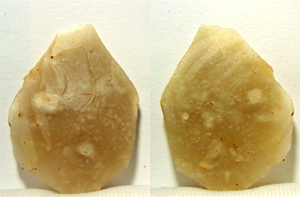Arrowhead (Neolithic)

Click ^ for larger image.
When found along a traditional footpath at Brislington Meadows, this flint was assumed to be a waste flake, which is a discarded fragment of stone knapped from the tool being made. Such finds are important archaeologically as they are evidence that Stone Age people were making tools at the site (other waste flakes have been found in these fields). The flake is so thin (no more than 2mm) that the stone is actually translucent.
Its size and shape was immediately reminiscent of a Neolithic arrowhead, but the similarity was disregarded because this flake lacks a pointed tip. Naturally, many arrowheads lose their tips during use, but this flake is so thin toward that place that it could never have had a sharp point.
Closer examination, however, reversed that negative appraisal. An accumulation of details - each insignificant on its own - elevated this flint from the status of waste flake to a leaf-shaped arrowhead (the characteristic form of a Neolithic arrowhead).
It's tempting to try place the various stages in the creation of this iconic tool into chronological sequence - such story-telling isn't great science of course, but it is at least plausible, and offers a way to get into the mind of the person who made it. Our speculation may begin with somebody purposefully striking a lump of flint with a hammer stone (our tool has a small but characteristic bulb of percussion). This process inevitably generated many waste flakes, some of which could have usefully sharp edges or points. The practiced eye of our flint knapper spotted unusual potential in one of the flakes.
Such a thin flake is easy to snap between finger and thumb. And a clean, straight break near the 'pointed' end was probably made in that way. Although seemingly casual, the break created just the right angle of an arrowhead tip. The same keen eye snapped a second piece away, which brought the body of the arrowhead curving back toward the barb (the part inserted into the wooden shaft of the arrow). The game was on - the flake could easily have been ruined by internal flaws causing the breaks to go in the wrong direction, but luck or skill was with our knapper - the shape was good.
To perfect the shape, three areas of the perimeter required attention, and tiny flakes have been taken from each of these, rounding the flake to give it a smooth, wafer thin cutting edge. But what of the missing tip? The flake here was naturally razor sharp, and with the weight of the shaft behind it, would have had no difficulty penetrating the feathers of a bird, or the skin of another small animal.
The usual leaf-shaped arrowhead is a facetted work of art, requiring great skill, concentration, and considerable time to create (so its loss would be a significant event). This lucky piece may have been seen a something of a 'throw away' item, having taken just a few minutes to craft. Perhaps it was given to a child to practise their archery skills. It could even have been made by a child from discarded scraps left by an adult making something else. A small chip in the tip suggests it was once fired at least once from a bow.
Material: stone
Period: Stone Age
Find spot: ST62597119, near the top of the field called Pool Close in the Tithe map.
Exhibit contributed by Ken Taylor
Text written by Ken Taylor
Photographer: Ken Taylor
Acquisition number: 220207a1